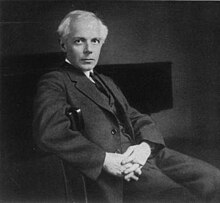Village Scenes
| Village Scenes | |
|---|---|
| by Béla Bartók | |
 Béla Bartók in 1927 | |
| Native name | Falun Dedinské scény Dorfszenen |
| Catalogue |
|
| Composed | 1924 (rev. Peter Bartók 1994) |
| Published | 1927: |
| Scoring | Female voice and piano |
Village Scenes, Sz. 78, BB 87a, also known as Falun, Dedinské scény, or its German title, Dorfszenen,[a] is a collection of Slovak folk songs for female voice and piano by Hungarian composer Béla Bartók. It was completed in 1924.
Background[]
Bartók, a composer primarily known for collecting and arranging folk music from central and eastern Europe, wrote this set of folk songs while on a project and journey around Europe that spanned several decades, starting around the 1900s. The folk tunes were collected in and around the Zólyom County area, which is in modern-day Slovakia, around 1915–6.[1] It was finished in December 1924, in , Budapest, and was engraved and published under Universal Edition some years later, in 1927, along with many other song collections made in earlier years. It then faded into obscurity until Béla's son, Peter Bartók, revised and republished the piece in 1994, by examining both the published version and the manuscripts left behind by the composer together with scholars Eve Beglarian and .[2]
Structure[]
The set consists of five songs and has a total duration of around 12 minutes. It is scored for a female voice and piano. The entire set has been translated into English by , German by , and Hungarian by .[3] The movement list is as follows:
| Song No. | Title (English) | Title (Slovak) | Title (Hungarian) | Title (German) | Incipit | Tempo marking | Bars | Duration[2][b] |
|---|---|---|---|---|---|---|---|---|
| I | Haymaking | Pri hrabaní | Szénagyűjtéskor | Heuernte | "Ej! Hrabajželen, hrabaj" | Largo | 26 | 1' 08" |
| II | At the Bride's | Pri neveste | A menyasszonynál | Bei der Braut | "Letia pávy, letia" | Lento | 20 | 1' 20" |
| III | Wedding | Svatba | Lakodalom | Hochzeit | "A ty Anča krásna" | Vivacissimo | 112 | 2' 35" |
| IV | Lullaby | Ukoliebavka | Bölcsődal | Wiegenlied | "Beli žemi, beli" | Andante | 73 | 3' 20" |
| V | Lads' Dance | Tanec mládencov | Legénytánc | Burschentanz | "Poza búčky, poza peň" | Comodo | 103 | 1' 46" |
Arrangements[]
Bartók wrote an arrangement of the last three songs of the set for a small choir of four to eight female voices and orchestra in 1926. This arrangement received the catalog numbers Sz. 79, BB 87b. It was completed in May 1926.
Recordings[]
- Mezzo-soprano and pianist Adrienne Krausz recorded this piece at the Festetics Palace, in June 1994. The recording was released on CD by .[4]
References[]
- ^ Carpenter, Alexander. "Falun, Village Scenes (5), for… | Details". AllMusic. Retrieved 24 January 2021.
- ^ Jump up to: a b Bartók, Béla (2010). Dorfszenen : slowakische Volkslieder für Frauenstimme und Klavier = Falun = Village scenes ([Partitur], Neuausg. 1994 ed.). Wien: Universal-Ed. ISBN 9783702423841. ISMN 9790008013959.
- ^ "Universal Edition". www.universaledition.com. Retrieved 24 January 2021.
- ^ Hicks, Michael (1996). Liner Notes of Pyramid Records 13509. Pyramid Records.
Footnotes[]
- 1924 compositions
- Song cycles by Béla Bartók
- Slovak music